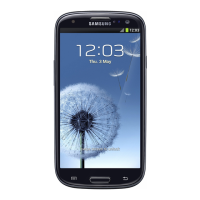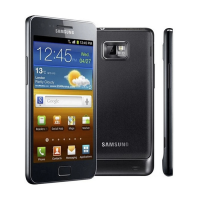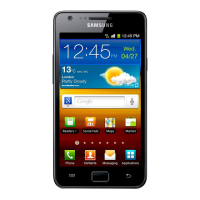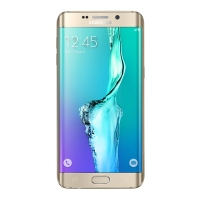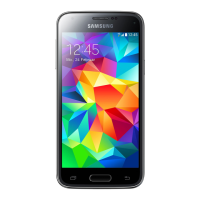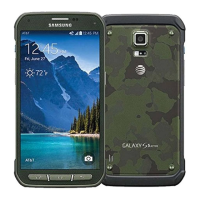Do you have a question about the Samsung GALAXY S III MINI and is the answer not in the manual?
Explains the structure and conventions used in the user manual for clarity and ease of use.
Provides step-by-step instructions for correctly installing the device's battery.
Details the process of charging the device's rechargeable Li-ion battery using the provided charger.
Guides users on how to power the phone on and off using the power button.
Outlines the initial setup process for configuring the device upon first use.
Highlights the key features and capabilities of the mobile device.
Illustrates and labels the components visible from the front of the phone.
Describes the phone's display screen, status bar, and access to application icons.
Defines key terms and conventions used throughout the user manual for clarity.
Explains how to manage and synchronize information from various accounts like Email and Google.
Details how to store, access, and manage contact information for friends and colleagues.
Describes how to assign shortcut numbers for quick calling of contacts.
Instructions on how to view the device's own phone number.
Guides on how to make emergency calls, especially if no SIM card is installed.
Explains how to answer incoming calls when the device is locked or unlocked.
Details how to view and manage the log of incoming, outgoing, and missed calls.
Provides instructions on how to adjust call volume using the volume keys during a call.
Explains how to enable and use the speakerphone feature during an active call.
Describes the different types of messages supported by the phone, including SMS and MMS.
Provides instructions on how to compose and send text and multimedia messages.
Details how to configure settings for text, multimedia, and voice messages.
Explains how to use the music application to play music files on the device.
Covers the features related to using the phone's built-in camera for photos and videos.
Describes how to view and manage photos and videos stored on the device.
Information on connecting to wireless networks, including Wi-Fi status indicators.
Details on Bluetooth technology, status indicators, and settings for wireless device connections.
Explains how to share the phone's internet connection as a Wi-Fi hotspot.
Guides on sharing the device's internet connection via USB cable or Bluetooth.
Instructions for connecting the device to a PC using various USB connection modes.
Provides guidance on finding, downloading, and installing new applications on the device.
Details how to use the phone's built-in calculator for arithmetic operations.
Explains how to use the Google Chrome app for web browsing on the phone.
Guides on accessing, purchasing, and downloading applications and games from the Play Store.
Explains how to activate Airplane mode to disable wireless communications.
Covers configuring and managing the device's Mobile Hotspot settings.
Details security settings for the phone, including encryption and screen lock options.
Explains how to set up various motion activation services for device interaction.
Provides instructions on how to change the current time and date displayed on the device.
Addresses concerns about cell phone radiation and its potential health effects.
Offers important guidelines for the safe handling, use, and storage of the device's battery.
Provides recommendations to avoid potential hearing loss when using audio devices.
Details what is covered under the limited warranty and for how long.
| Display diagonal | 4 \ |
|---|---|
| Touch technology | Multi-touch |
| Touchscreen type | Capacitive |
| Display resolution | 800 x 480 pixels |
| Native aspect ratio | 5:3 |
| Display number of colors | 16.78 million colors |
| Audio formats supported | AAC, AMR, FLAC, MP3, OGG, WMA |
| Video formats supported | H.263, H.264, MPEG4, VC-1, WMV |
| Processor cores | 2 |
| Processor family | - |
| Processor frequency | 1 GHz |
| Multimedia Messaging Service (MMS) | Multimedia Messaging Service (MMS) is a standard way to send messages that include multimedia content to and from a mobile phone over a cellular network |
| Personalization | Icons, Menu, Shortcuts, Widgets |
| Personal info management (PIM) | Calculator, Calendar, Events reminder, Notes, To-do list |
| RAM capacity | 1 GB |
| Compatible memory cards | MicroSD (TransFlash) |
| Maximum memory card size | 32 GB |
| Internal storage capacity | 8 GB |
| Flash type | LED |
| Front camera type | Single camera |
| Maximum frame rate | 30 fps |
| Video recording modes | 720p |
| Rear camera resolution (numeric) | 5 MP |
| Front camera resolution (numeric) | 0.3 MP |
| Talk time (2G) | 14.1 h |
| Talk time (3G) | 7.1 h |
| Battery capacity | 1500 mAh |
| Standby time (2G) | 460 h |
| Standby time (3G) | 500 h |
| 2G standards | EDGE, GPRS, GSM |
| 3G standards | HSPA |
| Wi-Fi standards | 802.11a, 802.11b, 802.11g |
| Bluetooth version | 4.0 |
| 3G bands supported | 900, 1900, 2100 MHz |
| Bluetooth profiles | A2DP |
| SIM card capability | Single SIM |
| 2G bands (primary SIM) | 850, 900, 1800, 1900 MHz |
| Mobile network generation | 3G |
| USB version | 2.0 |
| USB connector type | Micro-USB B |
| HDMI ports quantity | 0 |
| Headphone connectivity | 3.5 mm |
| Form factor | Bar |
| Product color | Blue |
| Platform | Android |
| App distribution platform | Google Play |
| Operating system installed | Android 4.1 |
| Subscription type | No subscription |
| Cables included | USB |
| Depth | 10 mm |
|---|---|
| Width | 63 mm |
| Height | 122 mm |
| Weight | 120 g |

